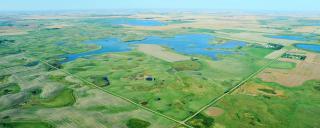
Wetlands and Lakes
Number of Basins: ~1,500,000
Description and Overall Condition: This landscape component includes all wetlands and lakes distributed throughout the state. There are more than 1 million wetland and lake basins in North Dakota, with densities of more than 150 wetlands per square mile in some areas. The draining, filling, burning, farming, or the complete destruction and alteration of wetlands, especially small temporary wetlands, is widespread.
From 1997 to 2009, more than 50,000 basins were lost, or -3.3% overall change. Wetlands located within cropland may be void of emergent vegetation, and those within pasture or range lands are often open to overuse by cattle use and degradation. Wetlands are dynamic and dependent on weather cycles may be in various stages of drought or deluge. The key to conservation of many SCP and other wetland associated wildlife is to provide a mosaic of wetlands and grasslands. Lakes in North Dakota are particularly susceptible to non-point source pollution, in part due to the great amount of agriculture in the state. No specific focus areas have been identified but nearly all wetlands play a vital role in filtering clean water, storage of surface water, and crucial wildlife habitat.
Predominant Natural Vegetation
Wetlands
fine-textured grasses, sedges, and rushes including common cattail, narrow-leaf cattail, hybrid cattail, Northern reedgrass, prairie cordgrass, phragmites, slender sedge, slough sedge, common spikerush, hardstem bulrush, river bulrush, slender bulrush, marsh smartweed, Baltic rush, sago pondweed, narrowleaf dock, Western dock, marsh cress, silverweed, rough cinquefoil, lanceleaf loostrife, claspingleaf dogbane, germander, marsh hegenettle, Western waterhorehound, wild mint, giant burreed, narrowleaf waterplantain, Western waterplantain, tall mannagrass, whitetop, sloughgrass, water parsnip, muskgrass, horned pondweed, grassleaf pondweed, coontail, white watercrowfoot, common watermilfoil, common bladderwort, Western wigeongrass softstem bulrush, water sedge, sandbar willow
Associated Species of Conservation Priority
Birds
horned grebe, american white pelican, american bittern, northern pintail, lesser scaup, canvasback, bald eagle, northern harrier, yellow rail, whooping crane, piping plover, american avocet, willet, upland sandpiper, long-billed curlew, marbled godwit, red knot, wilson’s phalarope, franklin’s gull, black tern, short-eared owl, le conte’s sparrow, nelson’s sparrow
Mammals
arctic shrew, pygmy shrew, river otter
Reptiles/Amphibians
plains spadefoot, canadian toad, snapping turtle
Insects
monarch butterfly
Other Characteristic Breeding Wildlife
Birds
common loon, pied-billed grebe, red-necked grebe, eared grebe, western grebe, double-crested cormorant, great blue heron, great egret, black-crowned night heron, white-faced ibis, Canada goose, wood duck, green-winged teal, mallard, blue-winged teal, Northern shoveler, gadwall, American wigeon, ring-necked duck, lesser scaup, common goldeneye, hooded merganser, ruddy duck, Virginia rail, sora, American coot, killdeer, spotted sandpiper, Wilson's snipe, ring-billed gull, California gull, common tern, Forster's tern, belted kingfisher, willow flycatcher, tree swallow, Northern rough-winged swallow, bank swallow, cliff swallow, marsh wren, yellow warbler, common yellowthroat, yellow-breasted chat, savannah sparrow, song sparrow, swamp sparrow, red-winged blackbird, yellow-headed blackbird, brown-headed cowbird
Reptiles/Amphibians
American toad, Great Plains toad, Woodhouse's Toad, gray treefrog, chorus frog, wood frog, Northern leopard frog, tiger salamander, common mudpuppy, painted turtle, common garter snake, plains garter snake
For more detailed information about this topic, please see the North Dakota Wildlife Action Plan.

